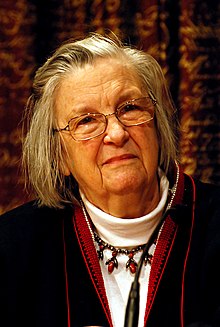
Back إلينور أوستروم Arabic الينور اوستروم ARZ Elinor Ostrom AST Elinor Ostrom Azerbaijani الینور اوستروم AZB Элинор Остром Bashkir Elinor Ostrom BAT-SMG Элінар Острам Byelorussian Елинор Остром Bulgarian এলিনর অস্ট্রম Bengali/Bangla
Elinor Ostrom | |
|---|---|
 Ostrom in 2009 | |
| Born | Elinor Claire Awan August 7, 1933 Los Angeles, California, U.S. |
| Died | June 12, 2012 (aged 78) Bloomington, Indiana, U.S. |
| Nationality | American |
| Education | University of California, Los Angeles (BA, PhD) |
| Spouses | Charles Scott Vincent Ostrom (1963–2012; her death) |
| Academic career | |
| Institution | |
| Field | |
| School or tradition | New institutional economics |
| Doctoral advisor | Dwaine Marvick |
| Contributions |
|
| Awards | |
| Information at IDEAS / RePEc | |
| Academic background | |
| Thesis | Public Entrepreneurship: A Case Study in Ground Water Basin Management (1965) |
Elinor Claire "Lin" Ostrom (née Awan; August 7, 1933 – June 12, 2012) was an American political scientist and political economist[1][2][3] whose work was associated with New Institutional Economics and the resurgence of political economy.[4] In 2009, she was awarded the Nobel Memorial Prize in Economic Sciences for her "analysis of economic governance, especially the commons", which she shared with Oliver E. Williamson; she was the first woman to win the prize.[5]
After graduating with a B.A. and Ph.D. in political science from UCLA, Ostrom lived in Bloomington, Indiana, and served on the faculty of Indiana University, with a late-career affiliation with Arizona State University. She was a Distinguished Professor at Indiana University and the Arthur F. Bentley Professor of Political Science and co-director of the Workshop in Political Theory and Policy Analysis at Indiana University, as well as research professor and the founding director of the Center for the Study of Institutional Diversity at Arizona State University in Tempe.[6] She was a lead researcher for the Sustainable Agriculture and Natural Resource Management Collaborative Research Support Program (SANREM CRSP), managed by Virginia Tech and funded by USAID.[7] Beginning in 2008, she and her husband Vincent Ostrom advised the journal Transnational Corporations Review.[8]
Since the 60s, Ostrom was involved in resource management policy and created a research center, which attracted scientists from different disciplines from around the world. Working and teaching at her center was created on the principle of a workshop, rather than a university with lectures and a strict hierarchy.
Ostrom studied the interaction of people and ecosystems for many years and showed that the use of exhaustible resources by groups of people (communities, cooperatives, trusts, trade unions) can be rational and prevent depletion of the resource without either state intervention or markets with private property.[9]
- ^ "No Panaceas! Elinor Ostrom talks with Fran Korten". Shareable: Civic System. March 18, 2010. Archived from the original on February 16, 2011. Retrieved February 20, 2011.
- ^ Janssen, M. A. (2012). "Elinor Ostrom (1933–2012)". Nature. 487 (7406): 172. Bibcode:2012Natur.487..172J. doi:10.1038/487172a. PMID 22785305.
- ^ Wilson, R. K. (2012). "Elinor Ostrom (1933–2012)". Science. 337 (6095): 661. Bibcode:2012Sci...337..661W. doi:10.1126/science.1227725. PMID 22879496. S2CID 206544072.
- ^ Aligica, Paul Dragos; Boettke, Peter (2010). "Ostrom, Elinor". The New Palgrave Dictionary of Economics (Online ed.).
- ^ "Nobel Prize Awarded Women". Retrieved October 14, 2019.
- ^ "Elinor Ostrom building for Nijmegen School of Management". Radboud University (in Dutch). Archived from the original on February 24, 2018. Retrieved February 3, 2018.
- ^ "Researcher for Virginia Tech program wins Nobel Prize". Virginia Tech. Retrieved January 2, 2011.
- ^ "Transnational Corporations Review". Taylor & Francis.
- ^ Ostrom, Elinor (1990). Governing the Commons: The Evolution of Institutions for Collective Action. Cambridge University Press. pp. 1–3. ISBN 978-0-521-40599-7.
© MMXXIII Rich X Search. We shall prevail. All rights reserved. Rich X Search